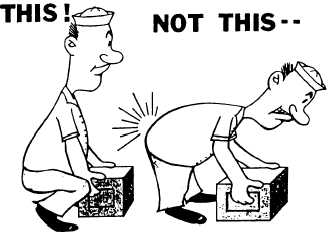| |
when stowing ship’s store stock. Some of these
fundamental; are required and some are effective
methods that have been used before in stowage
operations. Although they have proven to be
effective, knowledge and experience in using these
fundamentals afford the custodian of the bulk
storeroom the skills required to stow stock
properly.
SAFETY
Safety cannot be overemphasized in any phase
of the ship’s store operation and especially in
storeroom stowage. The safety precautions for
storeroom stowage are contained in the Navy
Safety Precautions for Forces Afloat, OPNAV-
INST 5100.19, chapter 2, “Storeroom Stowage.”
As the bulk storeroom custodian, you should be
familiar with these safety precautions and make
sure they are carried out in the bulk storeroom.
The ship’s store officer is responsible for
preparing appropriate safety precautions for the
bulk storeroom. These safety precautions should
be posted inside the bulk storeroom in plain view.
MANUAL HANDLING
All storeroom custodians should have a pair
of leather work gloves because much of the work
done inside the storerooms requires manual
handling of stock due to limited space. It is
important that you understand how to lift
correctly because many times custodians do not
think about how to lift or handle materials.
The results of improper handling of materials
may result in a painful hernia, a strained or pulled
muscle, or a disk lesion. The correct method of
lifting objects is shown in figure 3-6. You should
observe the following rules and precautions for
lifting:
1. Do NOT lift an object if it is too heavy or
too bulky for good balance. Get help or use
mechanical aids such as a dolly or hand truck.
2. Keep the load close to the center of your
body. The farther the load is from the small of
your back, the greater the strain. That is the
reason a heavy compact load is easier to lift than
a bulky, lighter load—you just cannot get the
bulky object close to you. The best way to handle
a compact load is to squat down close to the load
with one foot alongside it and the other foot
behind it. With the feet comfortably spread, you
will have better stability with the rear foot in the
position for the upward thrust of the lift.
Figure 3-6.-Manual lifting.
3. Pull the load toward you, then lift it
gradually. Avoid quick and jerky motions. Push
up on your legs while keeping your back straight.
A straight back keeps the spine, back muscles, and
other organs of the body in the correct alignment.
Tucking in your chin helps to align the spine. No
matter what size the load, get as close to it as you
can; then get a good grip by using the full palm
and extending your fingers and hands around the
object. Remember that your fingers have very
little power and need the strength of your entire
hand. Keep your arms and elbows tucked into the
side of your body to help keep the body weight
centered. Avoid twisting your body during the lift
or while moving the load; change directions by
moving your feet. Twisting your body during a
lift is one of the most common causes of back
injury.
4. Be sure to have a clear vision over the load
you are handling.
5. Do NOT change your grip while carrying
the load.
6. Face the spot in which you intend to set
the object down; bend your knees keeping your
back as straight as possible and the weight of the
object close to your body.
7. Always allow enough room for the load to
prevent injury to your toes and fingers.
8. When you are placing a load on the table
or bench, set it down on the edge and push it
forward with your arms and body. If the load is
too heavy or too awkward for you to move
alone—GET HELP! Remember: LIFT WITH
YOUR LEGS, NOT YOUR BACK!
3-11
|

